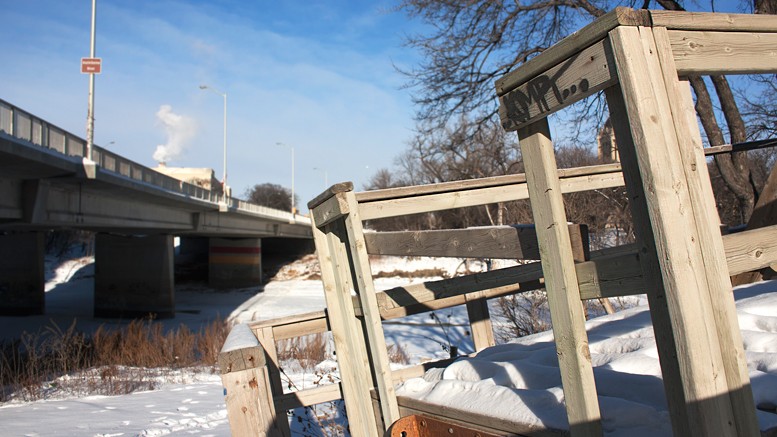A University of Manitoba civil engineering class is getting some real-world experience after the school entered into a joint partnership with the City of Winnipeg and several leading engineering companies with the aim of replacing a dilapidated dock at the foot of the Assiniboine River.
Located in the Gerald James Lynch Park near Osborne Village, the dock was abandoned largely due to accessibility issues combined with its failure to cope with fluctuating temperatures and water levels.
A city administrative report to a civic committee set the cost of improving the existing dock in the neighbourhood of $500,000, according to a Winnipeg Free Press article. It is hoped the collaborative effort with the U of M will result in an innovate design allowing for a future cost-effective structure to replace the current dock.
Doug Stewart, a retired consulting engineer and U of M alumnus, returned to lead the Engineering Canada-accredited capstone design course that will spearhead the project. It was his initiative, through approaching the public works department, that brought this the venture to fruition.
“The course is designed to near-as-practical mimic what goes on in the industry,” he said.
He noted the capstone program provides a framework for three groups to work in: the client, the students broken into groups, and members from the consulting and engineering community.
In this case, the client is the city of Winnipeg, while industry mainstays such as Aecon Group Inc. and MMM Group Limited stand as representatives of the engineering community.
In the past, university students have also worked with the province of Manitoba on larger scale multi-million dollar projects involving the construction of bridges and highway interchanges.
The capstone course is designed as a final push for graduating engineers who will soon be joining the work force. Featuring a seminal project, students are given the opportunity to network with real clients and engineering companies who provide mentors to aid each student group throughout the processes of researching, tabling proposals, coordinating group efforts, and drafting designs to meet the demands of their client.
“Without the course, they would step into their job and go ‘oh my god,’” said Stewart. “It’s almost a different language that goes on. I’m trying to soften the blow, so to speak, and help them avoid the pitfalls that young engineers will fall into.”
He assured, however, that there are professional engineers present at every step of the process. No student design goes forward without first being overlooked by one of the consulting firms involved in the planning stages.
Students first caught wind of the dock project due to an article published in the Winnipeg Free Press before the assignment was even announced to the class.
“I said, ‘wow, it’s already on the news,’” said Jun Xiong, a fourth-year civil engineering student. “It’s attracted a lot of attention and we’re really under the spotlight of the city now.”
Amber Skrabek, a spokesperson in the engineering department, said the program gives students the hands-on experience of working with a client to complete a project, even if their proposals aren’t acted upon.
“Just because the students are working on these real-world projects doesn’t necessarily mean that one of their solutions is going to be chosen or ever acted on,” she said, “but they’re given that opportunity to at least go through that process and present it to that client who really wants an answer.”
What may be seem like a highly daunting task doesn’t appear to have dampened students’ spirits. Instead, individuals are clamouring for the chance to tackle what’s proved a problem to city officials for years.
“They’ve given us quite the hope that one of [our proposals] will be chosen,” said fifth-year civil engineering student Ashley Haighs. “It’s kind of what’s expected. Not guaranteed, but they’ve put that little spark in there.”
“They’re hoping for something different, for fresh minds not so bound by what they’ve seen previously, because we haven’t seen anything previously,” ” added Hailey Collins-Kramble, also in her fifth-year studying civil engineering.
“There’s no habit, no preconceived notions; just what could we possibly do?”


